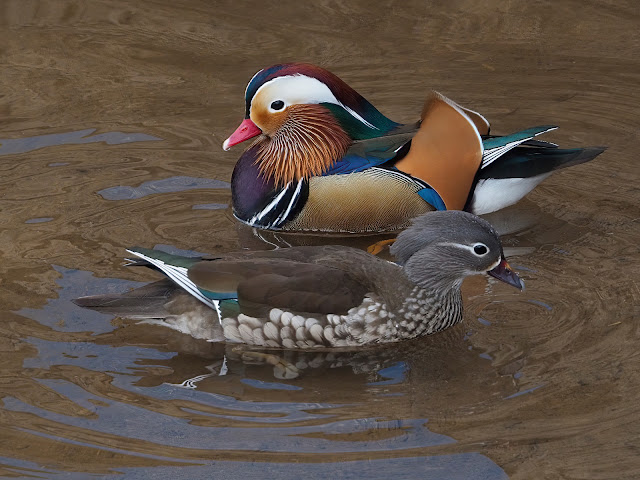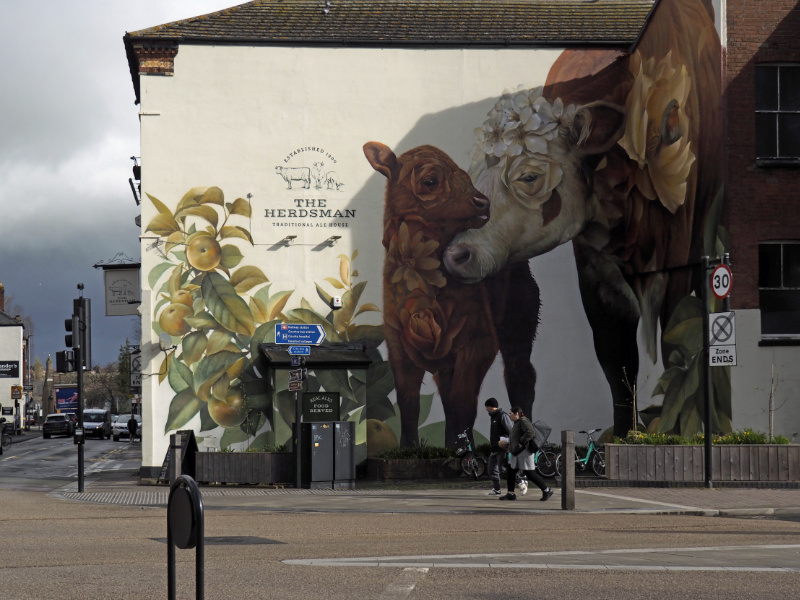A walk through the edge of the Forest of Dean near Cinderford took us through an area adjoining a "quag" i.e. quagmire. This particular area is looked after with a view to preserving the wetland characteristics that were once more common than they are now. It was a bright day with a quite strong wind and the ripples combined with the "real" trees and the reflected trees made for an interesting photograph.
photos © T. Boughen Camera: iPhoneSunday 28 April 2024
Friday 26 April 2024
Ramsons
The bluebells are past their best, as are the white-flowered ramsons that often accompany them. When I was young the Yorkshire Dales name for this plant was "stinking onions". Over the years I have increasingly heard them referred to as "wild garlic", and there are those who advocate picking them and using them in cooking, perhaps encouraged by this less derogatory name.
photo © T. Boughen Camera: Olympus OMD E-M10
Wednesday 24 April 2024
House Sparrow
The Royal Society for the Protection of Birds' "Big Garden Birdwatch 2024", concluded that the house sparrow (Passer domesticus) was the most common bird to be seen in the gardens of the UK, a position it has held for the past twenty one years in a row. In second place was the starling and the blue tit came third. The house sparrow held the top spot in the survey despite the species' sixty per cent decline since 1979. Interestingly, the house sparrow is one of the most widely distributed and most numerous birds in the world, a situation that came about with the help of mankind. The bird in today's photograph is a male of the species that was broadcasting its tuneless chirps from a buddleia bush.
photo © T. Boughen Camera: Nikon P900
Monday 22 April 2024
The Herefordshire School of Carvers
In the church of St Michael, Castle Frome, Herefordshire is a magnificently carved Norman font. It is the product of a group of sculptors who carved distinctive fonts and other objects within the county. They date from the twelfth century and incorporate a number of styles - Anglo-Saxon, Norse (Viking), Benedictine, Western France and Northern Italy. The font in Castle Frome is probably one of their last works, perhaps carved c.1150. The top of the font exhibits bold plaiting and the lower features interlace. In between are figures of the Evangelists and scenes telling the story of the baptism of Christ. St Luke holding a book is prominent in the photograph. At the base, in a different type of stone are three disfigured crouching creatures.
photo © T. Boughen Camera: Nikon Z 5
Saturday 20 April 2024
Chiffchaff
There are several onomatopoeic bird names, that is to say, names based on the call of the species. Cuckoo is probably the best known but curlew, peewit (a country name for the lapwing), jackdaw and kittiwake immediately spring to mind. So too does chiffchaff, a small warbler, a harbinger of spring named for its call that for the past couple of weeks has accompanied our daily walks.
photos © T. Boughen Camera: Olympus OMD E-M10
Thursday 18 April 2024
Lower Brockhampton House
Lower Brockhampton House is located in a small valley near Bromyard, Herefordshire. It is a timber-framed manor house that dates from the early 1400s. It is still almost completely surrounded by a moat, with a gatehouse of c.1542-3 giving the visitor access to the garden and main building. The house received additions in the 1600s and it remained a residence for most of its life until it was given to the National Trust in 1946. The last owner's family had lived there for more than twenty generations.
photos © T. Boughen Camera: iPhone
Tuesday 16 April 2024
Decorated church organ pipes
It has long been the fashion for the organ pipes in churches to be painted. A visit to major and minor churches is sure to present an opportunity to admire this form of decoration. Most examples will be from the nineteenth and twentieth centuries, but more recent examples may be seen too. The examples here are in Gloucester Cathedral and appear to use the acanthus leaf as the basis for the design. The colours are brighter than is often the case.
photo © T. Boughen Camera: Nikon Z 5
Sunday 14 April 2024
Robin red breast
click photo to enlarge
When I was young the robin (Erithacus rubecula) was often referred to as the "robin red breast". When I first heard this it struck me as odd because the robin's breast is clearly orange. I supposed that alliterative charm appealed more than colour accuracy. More importantly, however, is the fact that "orange" as a colour name didn't come into usage in Britain until the sixteenth century and prior to that date red was the nearest colour to orange. Interestingly one of the old names for the robin was the "ruddock", a word that also means red. This robin allowed a close approach, standing on the railings, probably hoping for some food from us.
photo © T. Boughen Camera: Olympus OMD E-M10
Friday 12 April 2024
Car door sculpture
I'm no fan of cars - nothing would please me more than to see the back of them and then witness their replacement by a comprehensive system of public transport that complemented proper provision for walkers and cyclists. We would gain so much and lose only a little - such as witnessing the work that automobile manufacturers and designers put into making the inside of a car door look like the output of a sculptor. This is a shot I took with my iPhone when I noticed the forms and textures of my car's door.
photos © T. Boughen Camera: iPhone
Wednesday 10 April 2024
The wren
One of Britain's small birds that are widely recognised by name is the wren (Troglodytes troglodytes) or, as it is colloquially known, "jenny wren". It is brown, short, rounded, with a relatively long beak and legs and a short tail that sticks up. It also has a much louder voice than you would expect. The wren is a regular visitor to gardens and, being small, suffers in harsh winters. Looking at the bird you can see why the designers of the farthing chose it to decorate the coin in circulation that was of the smallest value (see previous post).
photos © T. Boughen Camera: Olympus OMD E-M10
Monday 8 April 2024
The farthing
Recently I was wondering about British coins. Our current batch are, I think, a mixture of the good and the bad. One design that I find particularly unappealing features parts of heraldic figures - lions, harps etc - that mean little to the viewer who is unfamiliar with the whole from which the fragment is extracted. Another complaint I have is the relatively short duration of some of the designs. With that in mind I researched the eight new designs to be introduced in 2024 that feature various species of UK flora and fauna. I am pleased to say they look quite attractive.The inclusion of two birds, the puffin and the capercaillie, reminded me of the only other coin to have had a bird on it - the farthing (a quarter of a penny in value) - featuring the wren. This was taken out of circulation on 1st January 1961. The farthing featured in the photographs is the sole, and quite battered, example in our collection of old British coins.
photo © T. Boughen Camera: Olympus OMD E-M10
Saturday 6 April 2024
Colourful drake, drab duck
click phototo enlarge
In the world of birds it is quite common to find the male of the species to be relatively colourful in its plumage and the female to be more subdued. This isn't a universal rule, of course, and in species as disparate as the tree sparrow, the magpie, the kittiwake, the sand martin and the snipe, the male and female are pretty much identical. The distinction in colour is particularly noticeable in ducks. The most common duck, the mallard, has a colourful drake and a subdued female, the latter only sharing the purple speculum with the male. One of the biggest contrasts is between the male mandarin duck and the female, though in this case the female shares a couple of characteristics as well as having some unique features, such as the "spectacles".
photos © T. Boughen Camera: Olympus OMD E-M10
Thursday 4 April 2024
The solitary crow
In a tall, old pine at the edge of the grounds of a former hotel sat a carrion crow looking like the lord of all he (or she) surveyed. The crow didn't call, it simply looked first one way then another. Had it found a useful vantage point from which to spot the odd tit bit? Or was it near a newly built nest, tucked away in the branches, over which it was standing guard. I mean to check it out when we pass by on our walks around the town.
photos © T. Boughen Camera: Olympus OMD E-M10
Tuesday 2 April 2024
The Herdsman mural, Hereford
We came upon the mural in today's post purely by chance. A little research discovered that it is one of eight that aim to brighten up the city. I'm not the biggest fan of such things, but when the quality is good I can appreciate a mural as much as anyone. And this one is, I think, very good. It enlivens part of "The Herdsman" pub, a hostelry dating from 1900. The pub's name must surely derive from the location outside the former city walls on Widemarsh Street, along which cattle (and sheep) would be driven into the city, and where there was a cattle market.
The depicted cattle are, of course, the world-famous Herefordshire breed, and the apples may well be cider apples, the county and city being known for cider-making.
I can't explain the flowers that form part of the cattle, nor do I know quite why the robin has a visible heart, but these details all add interest to a fine piece of work, by Curtis Hylton, that is a pleasure to view.
photos 1 & 2 © T. Boughen Camera: Olympus OMD E-M10
photo3 © T. Boughen Camera: Nikon D5300

















